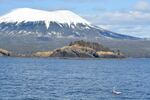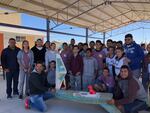On a warm fall day on the Oregon Coast, Sarah Collins’ fifth-grade classroom at Gearhart Elementary transformed itself into a bustling boatyard. One team spread a tarp in the schoolyard and carried out two hulls — almost as long as the students were tall — and then got to work painting them in multicolored stripes. Another team nearby set to work sanding the keels and prepping the hatches. Inside the classroom, a third team painted the sail.
“We are painting an American sunset because that’s the name of our boat,” said Sophia Bucher, wearing an oversized T-shirt as a smock.
The mini boats aren’t meant to carry human passengers, but they are meant to sail across the Pacific on their own, powered by wind and ocean currents. They’re part of an educational kit developed to teach ocean and environmental literacy. Other groups have built and sailed mini boats across the Atlantic, but no one has crossed the Pacific.
And that caught the imagination of Nate Sandel, the education director at the Columbia River Maritime Museum, when he first saw a mini boat at a STEMposium in 2017.
“I saw this really cool tool, and I thought, what sort of education program could we build around this tool?" he said. “And that sort of led to what sort of country are we connected to via currents and weather? Japan. And that led to the connection to the Japanese schools.”
So Sandel put out a call to fifth grade teachers in Oregon and Southwest Washington beginning in the 2017-2018 school year and worked with Japan’s Consul General in Portland to find partner classes in Japan.
The way it works is each American class builds two boats: One it will launch, and one it will send to Japan for its partner class to launch. Sandel puts students in charge of everything, from prepping, painting and assembling the boats to writing press releases for local media and letters to their sister schools using Google Translate.

The Kasagi gates of a Japanese temple washed up on the Oregon Coast after the 2011 tsunami.
Judson Randall / Portland Japanese Garden
It might seem far-fetched to think that some tiny boat, glued together by 10-year-olds, could sail some 4,500 miles across the Pacific on its own. But there is a local precedent. In 2011, the tsunami that struck Japan swept pieces of a temple out to sea and they crossed the ocean to wash up here on a beach in Gearhart.
“We sent back the top of temple thing that was really important to them, and it washed up on our beaches,” said Gearhart fifth-grader Brenna Lee. “We were like, ‘whoa, how did it get all the way here?’”
To emphasize the trans-Pacific connection, Sandel paired Gearhart Elementary with a class in Okuki Elementary, where students can actually see the shrine from their school's windows. (The temple gates were returned by the Portland Japanese Garden.)
After months of work, the Gearhart class headed to Astoria last January to set the American Sunset on its maiden voyage.
Following the nautical tradition, one student smashed a bottle of sparkling cider above the boat, and then Sandel took the boat aboard a Columbia River bar pilot boat to head out the mouth of the Columbia to the Pacific, waving “Bon Voyage!” as they pulled away.
“One of the biggest decisions that the students have to make is where are they going to launch their boats from,” Sandel said. “They look at all of the ocean currents over the last 12 months to get an idea how they're running, and they also look at the prevailing wind patterns.”
Other classes have asked U.S. Coast Guard and southbound freighters to launch their mini boats off Baja, hoping they’ll catch the North Equatorial Current to Japan. The Gearhart class chose the mouth of the Columbia with the hope their boat would ride the Alaska Current to cross the Pacific to the north.

The American Sunset catches the wind off the Oregon Coast.
Aaron Scott / OPB
Several miles out at sea, the bar pilots set the American Sunset into the water and watched its small sail catch the wind. Destination: Japan.
“It’s sort of like sending your kid away to college: You’re happy for them to spread their wings, but you’re going to miss them,” said Sandel, watching it go. “This boat has been a weekly part of my life since September, and those kids – all their hard work has made this happen. So it’s a really exciting, bittersweet moment.”
The American Sunset wasn’t the only thing bound for Japan, though. Every year, Sandel packs up the mini boats American students build for their partner classes, navigates them through airport security, and travels the 4,500 miles to deliver them himself.
The boats arrive with gifts from the American students, like books and salt-water taffy, sealed into their hull. Then the Japanese students finish decorating the boats, seal their own local mementos in the hull, stage their own maritime ceremony, and choose local sailors to set the boats on their course. Destination: America.
The hope is that, eventually, there will be two mini boats passing in the night.

Students at Okuki Elementary in Japan finish sealing the hull on the ship American students built for them.
Courtesy of Nate Sandel
While the boats are at sea, students on both sides of the Pacific track their progress via the solar-powered GPS units that ping their locations to National Oceanic and Atmospheric Administration satellites. The teachers also work the boats into lesson plans to study weather, maps, math and more.
In April, Sandel returned to the Gearhart classroom to check on the boats’ progress and lead the students through an exercise to hypothesize where the boats will go next.
Looking at a map of the Pacific with all the boats’ locations, the students calculated that the Go! Go! Okuki Go boat launched by the Japanese students in December had traveled 3,100 miles in a relatively straight line for America.
“To give you an idea, it’s sailed about as far as New York City to Gearhart,” Sandel told the students to gasps.
The American Sunset, on the other hand, seemed less eager to leave its shore.
“What do you notice about the American Sunset that no other boat has done?” asked Sandel, pointing at its southern course.
“It has gone down farther, down to San Francisco bay,” said Bucher.
“Yeah, and I got really excited because if the boat gets to about here, it’s going to hit those trade winds. You would take the trade winds — it would be the fastest way to go.”
To Bucher, the 396 miles that the American Sunset has sailed was just the beginning.
“It makes me feel proud of myself, because I just never felt like I could really build anything that can go all the way across the ocean to Japan,” she said.

A mini boat sails in front of Mt. Edgecumbe in Alaska's Sitka Sound.
Courtesy of Nate Sandel
The American Sunset was one of 20 mini boats launched last year in Sandel's program at the museum to circumnavigate the Pacific, trying to find their way through a world of seagulls and whales, wind and waves. One crashed in Alaska. One washed up in Baja. But others are more than halfway across. One found its way almost to the South Pacific before beaching on a tiny atoll named Kiribati.
“The boats that crash or give me heart attacks and anxiety because they’re hugging on shore, I think those are the really exciting ones,” said Sandel.
That’s because crashing is rarely the end of their story. Each hull carries a message in multiple languages asking finders to take the mini boat to the nearest classroom. And then Sandel works with that class and local sailors to get the boat fixed up and back on course.

When boats crash, Sandel works with classes near their crash site, like this one in Baja, to get the boats fixed up and back on course.
Courtesy of Nate Sandel
“The cool thing is every time this boat lands somewhere, we’re engaging a new group of people,” Sandel said. “So yeah, it is definitely making a huge community around the Pacific.”
And that’s the point. While it would be amazing if one of the boats makes it across, the project is really about introducing students on both sides of the Pacific to the wider world beyond their shores.
“At fifth grade, it's such a year of growth for them to, to learn about the world outside of our coastal region,” Gearhart teacher Sarah Collins said. She said the program has helped them understand science, measurements and more.
“To think about how there are kids halfway around the globe that are just like them and who are participating in the same thing and thinking about us, and we're thinking about them," she said. "It’s making them more global citizens versus just the citizens of Gearhart and Seaside.”
Sandel and three of this year’s participating fifth-grade classes will christen their boats and hand them off to the bar pilots in Astoria on Jan. 21. The event is open to the public.
And vicarious seafarers can follow the boats’ progress on the Educational Passages website.
